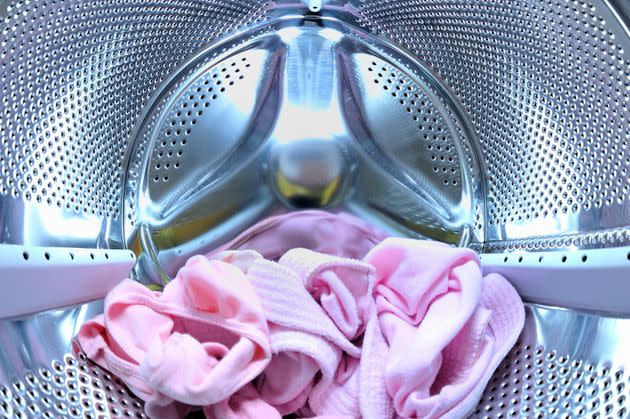We’re Dry Cleaners. Here’s What We Would Never Do With Our Laundry
- Oops!Something went wrong.Please try again later.

Everything has gotten more expensive, and our money just doesn’t go as far as it used to. This means many of us are inclined to cut back and curtail our monthly expenditures — and an easy luxury for many of us to cut back on is dry cleaning.
Do you really need to take your clothes to a professional? Couldn’t you effectively (and much more economically) clean your garments at home?
The answer is yes, maybe, but with a few caveats, and as long as you don’t submit your favorite silk dress or that fancy pair of pants you bought for more than half its retail price at Century 21 or Saks Off Fifth to some of the most common — and destructive — faux pas that people make when attempting to clean their own clothes.
We talked to two dry cleaners about the mistakes they would never make with their beloved laundry and what they really wish the rest of us would stop doing.
Be careful when you rub fizzy water into a stain.
You know when you’re out to dinner or lunch, and you spill olive oil or some kind of red sauce on your clothes, and you ask the waiter for some tonic water? And as you rub it into the spot and it disappears, you think, ‘Oh cool, I just got that out.’”
Before you do that, make sure it’s not actually tonic water, says Michael Jackson, franchise consultant at CD One Price Cleaners, a dry cleaning chain in the Midwest.
“What people fail to realize,” he said, “is that [tonic water] is full of sugar, so it oxidizes.” When you clean with tonic water, it pulls color from the fabric because of oxidation. Then, when you take the garment to the dry cleaner, the machine removes the color from the oxidized sugar, making the stain reappear — even though it was never actually gone.
“What happened is that sugar oxidized over the stain. That’s why it disappeared,” Jackson explained.
Furthermore, don’t rub a stain with anything.
“One universal rule is to never rub at a fresh stain,” said Matt Connelly of I Hate Ironing, an on-demand laundry and dry cleaning service in New York City.
This includes all modes of rubbing, whether with a cloth, sponge or your hands. You’ll most likely end up spreading the stain further into the fabric fibers, making it harder to remove. Another thing to avoid, according to Connelly, is hot water, which can set some stains into the fabric, rendering them next to impossible to get rid of down the line.
Instead, blot the stain with a cloth that’s damp with cold water. If you’re using a washing machine, spray your stain remover onto the stain, and then wash it in cold water. Do not throw it into the dryer unless it emerges from your washer stain-free. If the stain is still there after washing, repeat the process (again, avoid hot water or heat of any kind) or take it to a professional.
Don’t go too long between cleanings.
Number two on Jackson’s list is that many people don’t clean their clothes often enough.
“They think they’re saving money,” said Jackson, “but body oils and dirt (a lot of which might be invisible to the eye) gets in between the fibers.” This causes wear and tear, so your clothes wear out much faster.

Button-front shirts often suffer from this, especially in the collar and cuff areas, which will become discolored over time from sweat and general dirt, often to the point where it’s difficult to remove the soil.
Jackson recommends cleaning any article of clothing that touches the skin after each wear; this goes for underwear and most shirts. Clean garments like pants or sweaters after a couple of wears. Jeans are the exception and should be washed after every six to 10 wears.
Don’t use too much detergent.
If you use more than the recommended amount of laundry detergent, the released dirt and oils just swirl around in the soapy water in your machine and then land back onto the very clothes you’re attempting to clean, Jackson told me. You can listen to more details in a brilliant episode of HuffPost’s podcast, “Am I Doing It Wrong?”
“I think you only need about two tablespoons of detergent [for a load], so a bottle of laundry detergent might last you a year because you only need a couple of tablespoons for your clothes to come out clean,” said Patric Richardson, aka The Laundry Evangelist.
Don’t ignore the care labels.
Most people typically do not read care labels. “A lot of things can go wrong during the cleaning process,” said Connelly, “if you don’t follow care labels.”
Washing or drying something at too high a temperature can cause it to shrink beyond repair, especially if it’s made from cotton, wool or silk. Mixing colors during your wash can also result in dye transfer, where color seeps from certain garments onto others, and you end up with pink or gray socks instead of white ones (this is one most of us are likely quite familiar with).
“Most laundry accidents that come through our doors can be completely avoided by following the right cleaning instructions,” Connelly said. If you’ve removed the cleaning tag and are not sure how to wash it, you can usually still find instructions on the manufacturer’s website.
“Nobody reads cleaning labels,” Jackson said. “They throw whatever it is in the washer and the dryer, and then all of a sudden, it doesn’t fit anymore, and they’re unhappy.”

Stop using a lint roller (instead of a lint brush).
Jackson says he would never use a lint roller (the kind with the masking tape type substance on it) on a wool suit.
This is because they leave a bit of residue behind, which, he says, can lead to discoloration. Instead, usea lint brush. Lint brushes have a velvet-type surface that attracts and picks up dust, lint and fur.
Don’t take your leather or suede to a dry cleaner who doesn’t specialize in those materials.
Suede and leather are difficult materials to clean, and Connelly says some companies lack the required tools and expertise for the task. They’re extremely porous and absorbent, which means spills and other foreign substances soak in easily, and lengthy exposure to water (or heat) can cause damage like cracking, shriveling or shrinking.
Don’t put stained clothes in the dryer.
It will bake in! “The most difficult stain to treat is one the customer has messed with,” Jackson said.
This includes washing a garment and then tossing it into the dryer without seeing if the washing removed the soiled spot. If you still see the stain after a spin in the washing machine, do not put that article of clothing into the dryer! The heat will just bake the stain into the fibers.
Don’t leave your stained clothes in the hamper for too long.
Don’t wait to take your clothes to the dry cleaner, either. If something sits in your clothes or hamper for two weeks, whatever substance you dropped on it (pesto sauce, red wine, butter, mustard, whatever) will have all that time to embed itself into the fibers, making it more difficult for your dry cleaner to extract.
“It’s best to act fast when you have a stain,” Connelly said. “When in doubt, always take it to a professional to fix it.”
Despite all the horrific things Jackson has seen people do to their clothes and all the mistakes he and his colleagues have fixed as a result of these things, he loves working in the industry.
He explained that the most rewarding part of the industry is that they take something dirty, stained and/or spotted and that often looks as if it would be beyond salvaging, process it, clean it, press it and then present it back to the customer.
“And it looks good, right? And that makes everybody feel good. Makes us feel good, and it makes the consumer feel good,” he said.
Our advice? Find a dry cleaner like Jackson, and the next time you spill an entire glass of red wine on your lavender silk dress, get it to that cleaner as quickly as possible.
CORRECTION: A previous version of this article erroneously indicated that club soda has sugar in it. Club soda is sugar-free; tonic water has sugar.
